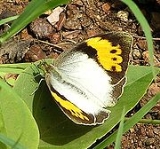
Ixias marianne
Encyclopedia
-_female_i_img_1135_.jpg)
_at_hodal_iws_img_1173_.jpg)
Butterfly
A butterfly is a mainly day-flying insect of the order Lepidoptera, which includes the butterflies and moths. Like other holometabolous insects, the butterfly's life cycle consists of four parts: egg, larva, pupa and adult. Most species are diurnal. Butterflies have large, often brightly coloured...
of the family Pieridae
Pieridae
The Pieridae are a large family of butterflies with about 76 genera containing approximately 1,100 species, mostly from tropical Africa and Asia. Most pierid butterflies are white, yellow or orange in coloration, often with black spots...
, (the yellows and whites) found in India
India
India , officially the Republic of India , is a country in South Asia. It is the seventh-largest country by geographical area, the second-most populous country with over 1.2 billion people, and the most populous democracy in the world...
and Sri Lanka
Sri Lanka
Sri Lanka, officially the Democratic Socialist Republic of Sri Lanka is a country off the southern coast of the Indian subcontinent. Known until 1972 as Ceylon , Sri Lanka is an island surrounded by the Indian Ocean, the Gulf of Mannar and the Palk Strait, and lies in the vicinity of India and the...
.
Description
The characteristics of this species vary according to the season of the year in which the eggsEgg (biology)
An egg is an organic vessel in which an embryo first begins to develop. In most birds, reptiles, insects, molluscs, fish, and monotremes, an egg is the zygote, resulting from fertilization of the ovum, which is expelled from the body and permitted to develop outside the body until the developing...
are laid.
Wet-season brood
_in_hyderabad_w_img_9541.jpg)
The underside of the wing
Wing
A wing is an appendage with a surface that produces lift for flight or propulsion through the atmosphere, or through another gaseous or liquid fluid...
is a rich sulphur-yellow as in other species of the genus, and is covered with reddish-brown, short, transverse striations and minute dots. The fore wing has an orange patch on the upperside which can be plainly seen because of the transparency on the wing, a broadly triangular area below this cell white, large and prominent discocellular spots with a white centre. Both fore and hind wings have a discal transverse series of reddish-brown spots, more or less conspicuous, the spots always centred with white. In other species in the genus these is characteristic of the dry-season broods. Oon the fore wing the patch above the tornus is prominent and in some specimens very large. The antennae
Antenna (biology)
Antennae in biology have historically been paired appendages used for sensing in arthropods. More recently, the term has also been applied to cilium structures present in most cell types of eukaryotes....
are reddish brown and the head and thorax anteriorly are covered with reddish-brown hairs. The upper side of the thorax is gray with white hairs and the abdomen is black. The under side of the head
Head
In anatomy, the head of an animal is the rostral part that usually comprises the brain, eyes, ears, nose and mouth . Some very simple animals may not have a head, but many bilaterally symmetric forms do....
, thorax
Thorax
The thorax is a division of an animal's body that lies between the head and the abdomen.-In tetrapods:...
and abdomen
Abdomen
In vertebrates such as mammals the abdomen constitutes the part of the body between the thorax and pelvis. The region enclosed by the abdomen is termed the abdominal cavity...
are white.
-_male_at_hodal_i_img_1204.jpg)
Dry-season brood
In both sexes this differs less from the wet-season form than it does in Ixias pyreneIxias pyrene
Yellow Orange Tip , Ixias pyrene is a small butterfly of the Family Pieridae, that is, the Yellows and Whites, which is found in India.-Description:Dry-season brood. Male upperside: deep sulphur-yellow...
and Ixias verna. The characteristic dry-season markings on the underside are more visible, on some occasions very much more pronounced.
The wing expanse in both sexes is 54–56 mm.
Distribution
The white orange tip is found from the northwest HimalayasHimalayas
The Himalaya Range or Himalaya Mountains Sanskrit: Devanagari: हिमालय, literally "abode of snow"), usually called the Himalayas or Himalaya for short, is a mountain range in Asia, separating the Indian subcontinent from the Tibetan Plateau...
to Kumaon
Kumaon Division
For Kumaoni/Kumauni People see Kumauni PeopleKumaon or Kumaun is one of the two regions and administrative divisions of Uttarakhand, a mountainous state of northern India, the other being Garhwal. It includes the districts of Almora, Bageshwar, Champawat, Nainital, Pithoragarh, and Udham Singh Nagar...
, Punjab, Bengal
Bengal
Bengal is a historical and geographical region in the northeast region of the Indian Subcontinent at the apex of the Bay of Bengal. Today, it is mainly divided between the sovereign land of People's Republic of Bangladesh and the Indian state of West Bengal, although some regions of the previous...
, central, western and southern India
India
India , officially the Republic of India , is a country in South Asia. It is the seventh-largest country by geographical area, the second-most populous country with over 1.2 billion people, and the most populous democracy in the world...
and Sri Lanka
Sri Lanka
Sri Lanka, officially the Democratic Socialist Republic of Sri Lanka is a country off the southern coast of the Indian subcontinent. Known until 1972 as Ceylon , Sri Lanka is an island surrounded by the Indian Ocean, the Gulf of Mannar and the Palk Strait, and lies in the vicinity of India and the...
.
Food plants
The food plant for the larvaLarva
A larva is a distinct juvenile form many animals undergo before metamorphosis into adults. Animals with indirect development such as insects, amphibians, or cnidarians typically have a larval phase of their life cycle...
e is Capparis grandis, a caper shrub in the Capparaceae
Capparaceae
Capparaceae , commonly known as the Caper family, is a family of plants in order Brassicales. As currently circumscribed, it contains 33 genera and about 700 species...
family.

